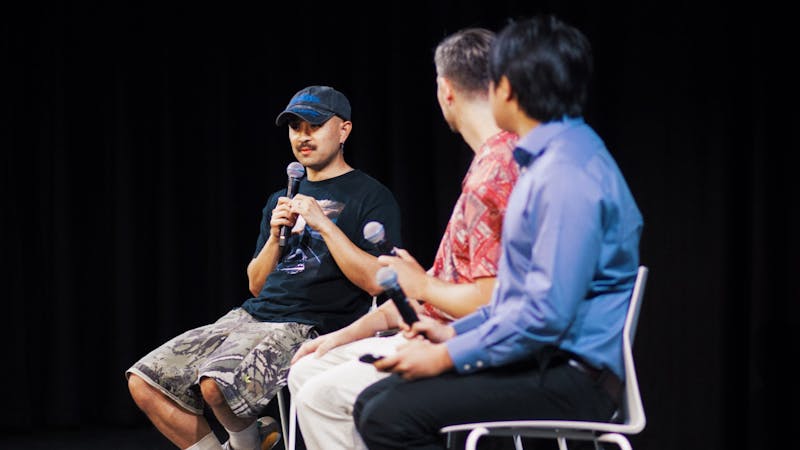william cordova explores infinite possibilities at Brochstein

An array of small, colorful squares — each a starkly different shade from its adjacent counterparts — cover Brochstein Pavilion’s south-facing wall. william cordova created this public art installation, titled “2800 dowling-wasi-sangarara,” as the newest piece in Rice’s ongoing art series, “Off the Wall.”
The exhibit is a partnership between the Moody Center for the Arts and the Glassell School of Art at the Museum of Fine Arts, Houston. It opened Friday, Aug. 29 and will remain on view for a year, through Aug. 23, 2024.
According to Frauke Josenhans, a curator at the Moody, the idea of the series was to invite an artist who has done the prestigious Core Residency Program at the Glassell School of Art every year to conceive specific work for the Brochstein Pavilion. “Off the Wall” had its first installation in 2019.
“[Brochstein is] such a modern building that really sits at the heart of the campus and students, faculty and visitors go there all the time … It’s a really prominent space on campus,” Josenhans said. “The idea was, let’s activate that space, the beautiful, really long, monumental wall inside, with artwork.”
“2800 dowling-wasi-sangarara” was inspired by two geographical locations important to cordova: Houston and Cuzco, Peru. Starting with photographic documentation, cordova said he abstracted and altered the images and used different materials, ranging from paint chips to graphite to collage elements, to create an overall abstract composition.
“I was interested in utilizing the space-time continuum theory as a way to address distinct historical events in different geographical locations and periods that allude to similar scale factors,” cordova wrote in an email to the Thresher. “The installation is more of a portal … [It’s an] ephemeral monument or ghost monument, as cultural practitioner David Hammons would put it. Ideally, it is a trans-physical space for meditation and recovery all at once.”
Josenhans said the program invited william cordova because of his rich cultural background. cordova grew up in Lima, Peru, but spent his childhood in Miami. He went on to receive a B.F.A from School of the Art Institute of Chicago and an M.F.A from Yale University, completing residency programs in the U.S. and abroad. Now, his artwork draws inspiration from disciplines across the board, merging architecture, mathematics and cosmogony into distinct abstract pieces.
“When we select an artist, we’re really trying to keep in mind the nature of the space. It’s public, it is very exposed. We really were trying to find an artist who’s up for the challenge,” Josenhans said. “william just seems like a perfect fit, given his really interesting practice and seeing how he works, often referring to transition and displacement in his works of art, but also our perception of places, images.”
Josenhans said one of her favorite parts about the Off the Wall series is that it positions artists to embrace the challenges of displaying art in a public space. According to Josenhans, cordova’s work also engages with many topics that are important to Rice, making it ideal for a public campus space.
“There are so many topics that the artist alludes to in his work that students from different fields and departments can find different ways to engage with it,” Josenhans said. “I think it also speaks to the great international nature of Houston and of Rice University. Houston is the fourth biggest city in the country, and it’s so international.”
Josenhans said showcasing work with an emphasis on the diversity of Houston and the Rice community is important to the Moody.
“There are so many different cultural influences that are prominent in the city. That’s also true for the Rice campus, with the student body being so informed by all these different countries where students are coming from,” Josenhans said. “So work that reflects the diversity and cultural richness that you can find on campus is important.”
cordova agreed and said that different Rice programs — from astrophysics to the Electroacoustic Music Labs to African American Studies and Latin Studies — all have thematic relationships woven into the fabric of the installation. cordova said he hopes everyone will take their own meanings from the piece.
“We are already a community with infinite possibilities,” cordova said. “Infinite perceptions, infinite perspectives, infinite conclusions.”
More from The Rice Thresher

Worth the wait: Andrew Thomas Huang practices patience
Andrew Thomas Huang says that patience is essential to being an artist. His proof? A film that has spent a decade in production, a career shaped by years in the music industry and a lifelong commitment to exploring queer identity and environmental themes — the kinds of stories, he said, that take time to tell right.

Andrew Thomas Huang puts visuals and identity to song
Houston is welcoming the Grammy-nominated figure behind the music videos of Björk and FKA twigs on June 27.

Live it up this summer with these Houston shows
Staying in Houston this summer and wondering how to make the most of your time? Fortunately, you're in luck, there's no shortage of amazing shows and performances happening around the city. From live music to ballet and everything in between, here are some events coming up this month and next!

Please note All comments are eligible for publication by The Rice Thresher.